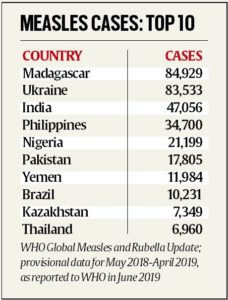WHERE INDIA STANDS IN BATTLE AGAINST MEASLES, HOW SRI LANKA ELIMINATED IT
- Sri Lanka has made health history after spending three years free of any new measles cases and the World Health Organisation (WHO) has declared that the deadly childhood infection has been eliminated in the island nation.
- In contrast, India has a long road ahead, particularly because vaccine-resistant voices are sometimes being heard.
- Last year, the Delhi High Court had put on hold a vaccination campaign citing lack of parental consent.
A Look At The Battle Against Measles
The Disease:
- Measles is a serious and highly contagious disease that can cause debilitating or fatal complications, including encephalitis, severe diarrhoea and dehydration, pneumonia, ear infections and permanent vision loss.
- The disease is preventable through two doses of a safe and effective vaccine.
- India currently gives a measles rubella vaccine in its universal immunisation programme to tackle both measles and rubella.
- Rubella, more commonly known as German measles, can have severe consequences during pregnancy. An infection just before conception and in early pregnancy may result in miscarriage, foetal death or congenital defects known as congenital rubella syndrome (CRS).
- A woman infected with the rubella virus early in pregnancy has a 90% chance of passing the virus to the foetus.
Status in India:
- The latest Global Measles and Rubella Update, which lists provisional data received in June and covering the period between May 2018 and April 2019, says India reported 47,056 measles cases and 1,263 rubella cases during these 12 months.
- India, as part of the global initiative, has targeted elimination of measles and control of rubella by 2020.
- Rubella control is achieved when a country reduces the number of rubella cases by 95% as compared to cases in 2008.
- India has initiated the world’s largest Measles-Rubella (MR) Campaign targeting vaccination of 410 million children and adolescents aged between 9 months and 15 years.
- The MR campaign began in February 2017, and as of November 2018, 135 million children have been vaccinated in 28 states/UTs.
- Under the programme, two doses of measles and rubella vaccines are to be given at ages 9-12 months and 16-24 months.
The Sri Lanka milestone:

- Sri Lanka is the fifth country in WHO’s Southeast Asia region to eliminate measles.
- The other four countries are Bhutan, Maldives, DPR Korea and Timor-Leste.
- Sri Lanka’s success follows its persistent efforts to ensure maximum coverage with two doses of measles and rubella vaccines being provided in the childhood immunisation programme.
- The vaccination coverage in the country has been consistently high – over 95% with both the first and second doses provided to children under the routine immunisation programme. Additionally, mass vaccination campaigns with a measles-rubella vaccine have been held periodically to plug immunisation gaps, the last one in 2014.
- The country has a strong surveillance system and all vaccine-preventable diseases are an integral part of the communicable disease surveillance system. Measles is a notifiable disease in the country.
- Last year, Sri Lanka achieved rubella control, along with five other countries — Bangladesh, Bhutan, Maldives, Nepal and Timor-Leste.
Comeback Concerns:
- Globally, there are concerns about vaccination gaps that are allowing the disease to resurface in areas where it is not very common.
- In 2019, a large number of American states including Arizona, California, Colorado, Connecticut, Florida, Georgia, Idaho, Illinois, Indiana, Iowa, Kentucky, Maine, Maryland, Massachusetts, Michigan, Missouri have reported measles cases to the Centers of Disease Control (CDC) Atlanta.
- In 2017, over 109,000 deaths occurred from measles all around the world. A global report by WHO and CDC Atlanta, released last year, said that since 2000, over 21 million lives have been saved through measles immunisation.
- However, reported cases increased by more than 30 per cent worldwide from 2016. The maximum upsurge in such cases in 2017 was reported from the two Americas, Eastern Mediterranean region and Europe, while Western Pacific was the only WHO region where measles incidence fell.
- For several years, the global coverage with the first dose of measles vaccine has stalled at 85 per cent. This is far short of the 95 per cent needed to prevent outbreaks, and leaves many people, in many communities, susceptible to the disease. Second dose coverage stands at 67 per cent.






